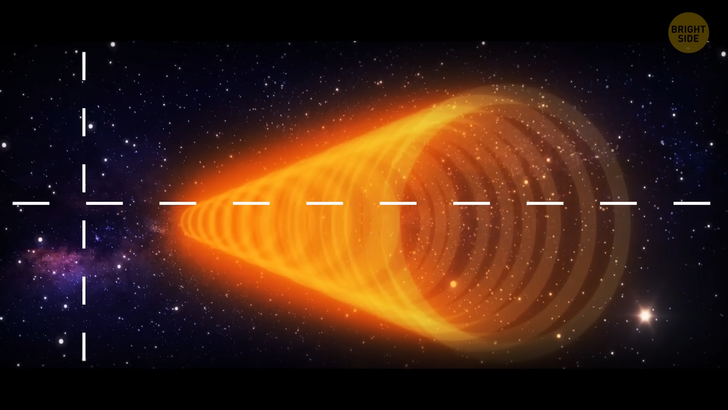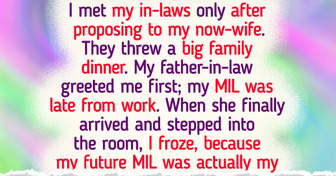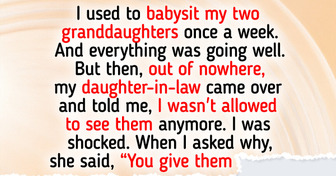14 Times Employees Handled Toxic Jobs Like Absolute Pros


Did you know that there’s an astronomical object in which space and time actually swap places? How does it work? And what exactly does “swapping space and time” mean? Well, let’s figure it out. Imagine that you’re on a spacecraft.
The vehicle can only move straight. Your path leads to some inevitable point, and you have no idea what lies ahead. You can only hope that it won’t be too bad. Meanwhile, everything around you is complete madness. A chaotic collage of many historical events.
What do you see? Ancient humans and dinosaurs? The birth of the universe? A... future? Who knows. That’s what the universe would look like if we swapped time and space. And, theoretically, this is what you’d see if you fell into a black hole and somehow were able to survive. But how is something like this even possible?

First of all, let’s discuss “time” and “space”. Imagine drawing a light bulb on a sheet of paper. Then grab one more sheet and draw how it lit up. Right now, it’s just a small circle of light. Another sheet — the circle of light is growing. It gets bigger and bigger in size, until, finally, it turns into a huge circle.
In real life, the bulb lights up in the blink of an eye. That’s because the speed of light is the fastest in the universe. But here, on our drawings, we captured the propagation of light frame by frame. We see how over time the light has grown from a small dot to a large circle. But if you connect these circles...
Doesn’t it remind you of some shape? For example... A cone? Yes, exactly. This is called a “light cone”. And “time” is the central axis of this cone. Why? Because light turns from a small dot into a large circle over time. To remember it, let’s draw a “time vector” — an arrow inside the cone. It goes from the past to the future.

Meanwhile, the circles are “space”. In space, we can move however we want, in any direction. We can move up, or down, in zigzags and so on. But, no matter what zigzags we draw, along the timeline, we’re always moving forward. We can’t turn back time, and we can’t stop it.
This helps us define “time” and “space”. Time is the direction in which the light cone is oriented. This is the direction where all our paths lead, and where our future inevitably lies. And space is the whole variety of directions perpendicular to the timeline. This is a straightforward graph.
If it could be applied to the entire universe, then time would flow the same everywhere. However, if you’ve watched at least some popular sci-fi movies, you know that this isn’t the case. In reality, time can be crazy!
For example, if you’re chilling near a black hole, what will be 2 hours for you may turn out to be 20 years for your friend on Earth. But why? Take a deep breath. Now, gravity comes into play. “Oh, I know about gravity. It’s that thing that helps me to stand on the ground”, you may think. But it’s much, MUCH more complicated than that.

Gravity is one of the basic physical forces in our world, and it’s incredibly powerful. In fact, she’s such a girl boss that she can distort space AND time. She literally can influence the speed of time like an almighty wizard. How? Well, let’s take something slightly bigger than a light bulb. For example, a supernova. Somewhere in the universe, a star has just made a “boom”. How do we know about it?
Well, nothing in the universe — no sound, no radio waves, nothing — travels faster than light. So we’ll know about the birth of a supernova only when we see it. And this will happen only when its light cone grows enough and reaches our planet. So, the light cone grows and grows... So far, everything is fine. And finally, it reaches our planet. But there’s a catch. You see, our planet is massive. VERY massive. And it has pretty strong gravity. What happens then?
Gravity changes the direction of the light cone. It begins to attract the cone to the center of our planet. And with it, it also attracts our “arrow of time”. That means, it slows the time down. And the closer the light cone is to us, the more the arrow bends, and the slower time goes. What does it mean?
For example, the fact that the watch on your ankle will lag behind the watch on your wrist. That your head is aging faster than your legs. And that astronauts in Earth’s orbit age a little slower than people on Earth. This is what scientists call “general relativity”. Right... But how does this relate to our topic?

How can we understand what will happen if we swap space and time? Don’t worry. We’re almost there. Now imagine a cosmic body with incredibly strong gravity. It bends time and space SO MUCH that it feels like they swap. This is a black hole. A black hole attracts absolutely everything to its center. No stars, planets, no light can escape from there.
Let’s say our light cone is approaching it. First, as usual, time begins to bend towards the center of the black hole, attracted by its gravity. But the gravity is VERY strong. So it bends more and more... And time goes slower and slower the closer you’re to the center. In the end, the light cone crosses the boundary of the black hole... the so-called “event horizon”.
At this point, it got so distorted that now it’s literally pointing downwards. We can say that time has “changed its direction”. “Time is pointing downwards?! What kind of nonsense is that?!”, you may ask. It will be easier to explain in a real example. Imagine you’re a crazy astronaut who decided to jump into a black hole. And there’s an observer in a spaceship who watches you doing this for some reason.

At first, for you, nothing changes. You look at your watch, you see that 5 minutes have passed, and everything is okay. But for the observer? First of all, you’ll fall for a VERY long time. The observer has been sitting there for 50 years, and you’re still falling — all because your time has slowed down.
Secondly, since space is also distorted near the black hole, the observer will see how you’ll begin to stretch like spaghetti. This is a scientific term, by the way — it’s called “spaghettification”. And then, you finally cross the event horizon.
The observer doesn’t see you anymore. Light cannot escape from a black hole, so your image won’t reach the observer, even if you’re still inside. And what about you? What if you somehow survived? Remember, the time arrow is pointing to the center of the black hole. What does it mean? It means that now, the center of the black hole is your future.
It isn’t a place. It’s a fate that you can’t change. And wherever you came from, as well as the rest of the universe, no longer exists for you. Because now, it’s not a place, but an event from the past. And since you can’t turn back time, you’ll never be able to come back. But what is around you? Complete chaos. The rays of light now move in all directions — forward, backward, and so on...

The rays depicting the events of the past, the future, the present — all this is moving around you. In reality, space and time didn’t swap places. But it feels like they did.
Because in space, you can now only move forward, as if along a straight line. And time, reflected in the light rays, surrounds you everywhere and moves in all possible directions. And here we go back to the beginning. This horrifying example helps us imagine what it would feel like if time and space got reversed.
Of course, all this is just theories and guesses. The very idea that we’re moving in some one direction, the one we haven’t chosen, and there’s complete time chaos around, sounds quite frightening. And yet, it would be a very interesting experience. Sounds dangerous. You go first.











